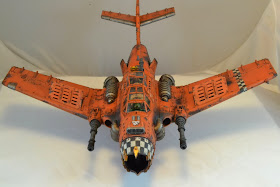Here's the Finished Product!
I completed the base this evening. Unless I decide to add some flocking or grass tufts (which I'm likely to do). The painting, at the very least, is totally complete. I kept the base simple, but focused on some weathered accents in the abandoned oil drum, and rusted bucket. I really enjoyed mucking up these two items, especially the barrel.
I Love Rust and Such
I used some very simple techniques and the outcome was terrific. Here's a quick step-by-step:
- I based coated the barrel with the old Knarloc Green which is now called Loren Forest (Citadel paint).
- Then applied the transfers like this: a gloss coat, put down the two transfers, applied micro-sol, let it dry, then applied matte coat to seal the transfers in.
- Once the matte coat was dry, I took a sponge and some Knarloc Green (Loren Forest), and dabbed it over the transfers to "rough them up" a bit.
- Applied a wash of Agrax Earthshade across the whole barrel. I made sure to reapply to recesses that would have a larger collection of dirt, rust, and oil.
- I then used the new technical paint Typhus Corrosion. I applied it very heavily to the bottom of the barrel, and along the underside to show that it might have been slapped around in the mud just a bit when it was hurriedly left by the Imperials. Typhus Corrosion leaves a grit, which would be vital to the next step.
- I dabbed Vallejo Pigment (or weathering powder) Dark Red Ochre (sic) around the bottom of the barrel were the Typhon Corrosion was thickest. Once applied fully, I took a clean brush loaded with white mineral spirits and carefully tapped over the powder. The mineral spirits really flow of the brush and quickly run across the model. I do this to "pull" the pigments onto the model.
- Once the mineral spirits have dried (this is a pretty quick process) I now very carefully dabbed matte finish over the rusted areas, and then eventually brushed over the entire barrel.
Oil Spill
Another really easy effect is the look of some leaked oil onto the mud. It's a bit hard to see in the picture, but shows up well in person, but essentially all I did was apply a pool of black wash to the earth near the lid. Once dried I then coated the same area with a gloss coat. This looks like oil soaking into the ground, but still a little fresh.
Secret Weapons Miniatures Base Review
This base from Secret Weapons Miniatures is quite nice. Though it doesn't scream out with detailed features, it fits perfectly with the rest of the army. I pictured my Orks on a dreary wasteland, harsh and unforgiving, but with plenty of space to speed about. I liked the subtle tire tracks through the dirt, and the very simple rocks. The most important feature for me was that there would still be space for me to attach my flight stand and most all of the Secret Weapons line of bases seem to be very reasonable in the amount of room you have to actually mount a model. I have a number of other bases that I've purchased from them and all bases arrived nearly completely flash free and with a low amount of mold release on them. This means they are quickly cleaned up and ready for models. My one possible complaint would be that the edges sometimes need a bit of filing to get absolutely smooth. This is really a very minor complaint and honestly if you're in this hobby you're probably more than willing to spend a few minutes filing or sanding to make sure everything is just so.
A quick word on how I put the flight stand and base together: In order to attach the stand, I traced out the stand before I painted, and carefully carved out a very shallow smooth footprint for it to make solid contact with the base. I then pinned it in as a final measure. I'm still going to be awfully careful with this flight stand, as it certainly isn't the most aggressive way to attach it to a base.
Thanks for Stopping By!
I appreciate everyone that comes by to view my work. Any feedback is appreciated and I'll be happy to answer any questions. I'll just leave you with some more pictures of my completed project, enjoy!


















